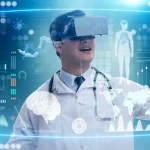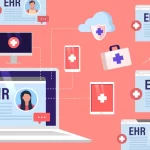
Exploring the Latest in Telehealth and Telemedicine Innovations
November 26, 2023Introduction: Navigating the Technological Waves of Telehealth
A. Technological Advancements Driving Telehealth Growth
- Accessibility and Cost-Effectiveness: In the ever-evolving landscape of healthcare, technological advancements have become the wind beneath the wings of telehealth. The core drivers of telehealth growth lie in its ability to enhance accessibility and provide cost-effective solutions for patients. As the world embraces the digital age, telehealth emerges as a transformative force, breaking down barriers and extending the reach of healthcare beyond traditional boundaries.
B. Focus on Latest Innovations in Telehealth and Telemedicine
- Virtual Visits: The heartbeat of telehealth innovation, virtual visits redefine the patient-provider relationship. Through secure video conferencing and real-time communication tools, patients can connect with healthcare professionals from the comfort of their homes, fostering convenience and accessibility.
- Wearable Health Monitoring: The advent of wearable technology amplifies the scope of telehealth. From smartwatches to fitness trackers, wearables serve as health companions, continuously monitoring vital signs and providing valuable data for remote patient management.
- Remote Patient Monitoring: Telehealth extends its embrace through remote patient monitoring, a paradigm where patients’ health data is collected in real-time from their homes. This real-time stream of information enables healthcare providers to monitor chronic conditions, detect anomalies, and intervene proactively.
- Chronic Care Management at Home: The home becomes an extension of the healthcare ecosystem through chronic care management at home. Telehealth platforms empower patients with chronic conditions to actively participate in their care, supported by remote monitoring, virtual consultations, and personalized care plans.
As we delve into the world of telehealth, the focus sharpens on the latest innovations propelling this transformative wave. From virtual visits breaking down geographical barriers to wearable health monitoring redefining proactive healthcare, and from remote patient monitoring enabling real-time insights to chronic care management finding a new home in patients’ daily lives—telehealth emerges not just as a technological advancement but as a beacon illuminating the future of healthcare delivery.
Virtual Visits: Revolutionizing Healthcare Access
A. Growing Popularity of Virtual Visits
- Convenience and Cost-Effectiveness: Virtual visits have become the hallmark of telehealth, gaining immense popularity due to their inherent convenience and cost-effectiveness. Patients no longer need to travel long distances or endure waiting rooms; instead, they can access healthcare services from the comfort of their homes. This shift in accessibility not only enhances patient convenience but also addresses cost-related barriers, making healthcare more attainable for diverse populations.
- Real-Time Communication through Video Conferencing: The heart of virtual visits lies in real-time communication facilitated by video conferencing. Patients and healthcare providers can engage in face-to-face consultations, fostering a sense of connection and personalized care. This dynamic interaction transcends geographical boundaries, enabling patients to consult with specialists or seek second opinions without the constraints of physical proximity.
- Accessing Care from the Comfort of Home: The transformative power of virtual visits is encapsulated in the idea of accessing care from the comfort of home. This not only caters to the needs of individuals with mobility issues or chronic conditions but also resonates with a broader demographic seeking healthcare solutions that align with their lifestyles. The home transforms into a healthcare hub, where the traditional barriers to care dissolve in the virtual realm.
Virtual visits represent more than a technological advancement; they symbolize a paradigm shift in healthcare delivery. As they continue to gain popularity, virtual visits redefine the patient experience, making healthcare more accessible, patient-centric, and aligned with the evolving expectations of the digital age.
Wearable Health Monitoring: Pioneering Personalized Healthcare
A. Role of Wearable Health Devices
- Smartwatches and Fitness Trackers: Wearable health devices, embodied by smartwatches and fitness trackers, take center stage in the era of personalized healthcare. These devices seamlessly integrate into daily life, becoming constant companions in individuals’ health journeys. With functionalities extending beyond mere timekeeping or step counting, these wearables evolve into health-centric tools, empowering users to take charge of their well-being.
- Real-Time Tracking of Vital Signs: The heartbeat of wearable health monitoring lies in its ability to offer real-time insights into vital signs. From heart rate and sleep patterns to activity levels and stress indicators, wearables provide a continuous stream of data. This real-time tracking enables individuals and healthcare professionals to monitor health trends, identify deviations, and intervene proactively.
- Early Detection of Complications for Improved Outcomes: Wearable health devices emerge as early sentinels, detecting subtle changes that may signal potential health complications. By offering early warnings and alerts, these devices empower individuals to seek timely medical attention, fostering a preventive healthcare approach. The result is not just the detection of issues but the proactive management that leads to improved health outcomes.
In the realm of healthcare, wearable health monitoring transcends being a trend; it becomes a transformative force. From enhancing daily life with smart features to offering a continuous stream of health data, wearables redefine how individuals engage with their well-being. As these devices evolve, they not only contribute to personal health insights but also weave a tapestry of interconnected data that holds immense potential for advancing medical research and public health initiatives.
Remote Patient Monitoring (RPM): Unveiling a New Era in Healthcare
A. Utilizing IoT and Mobile Devices
- Real-Time Tracking of Health Data: Remote Patient Monitoring (RPM) heralds a new era in healthcare by harnessing the power of the Internet of Things (IoT) and mobile devices. Through connected sensors and smart technology, RPM enables the real-time tracking of a myriad of health data points. From vital signs to medication adherence, patients’ health metrics are continuously monitored, creating a comprehensive and dynamic health profile.
- Early Intervention and Improved Patient Outcomes: The crux of RPM lies in its capacity for early intervention. By providing healthcare professionals with real-time data, RPM facilitates prompt identification of deviations from baseline health indicators. This early detection empowers clinicians to intervene proactively, adjusting treatment plans or providing timely guidance to patients. The result is an enhanced potential for positive health outcomes and a reduction in the likelihood of complications.
- Reducing Hospital Visits with RPM Technology: One of the groundbreaking impacts of RPM is its ability to significantly reduce the need for hospital visits. By enabling continuous monitoring outside the traditional healthcare setting, RPM offers a proactive and preventive approach to care. Patients can stay connected with their healthcare providers without the necessity of frequent clinic or hospital visits, leading to a more efficient and patient-centric healthcare model.
Remote Patient Monitoring, fueled by IoT and mobile technology, is not merely a technological advancement—it’s a paradigm shift in how healthcare is delivered and experienced. As RPM continues to evolve, its potential to enhance patient outcomes, reduce healthcare costs, and redefine the patient-provider relationship makes it a cornerstone in the trajectory of modern healthcare.
Chronic Care Management at Home: Transforming Lives Through Empowerment
A. Support and Resources for Chronic Conditions
- Empowering Patients for Effective Health Management: Chronic Care Management at Home redefines the landscape for individuals living with chronic conditions. It goes beyond traditional models of care by providing patients with the support and resources needed for effective health management. Through a combination of technological tools, educational materials, and personalized care plans, individuals gain the knowledge and empowerment to actively participate in their care.
- Reducing the Need for Frequent Hospital Visits: A key facet of Chronic Care Management at Home is its ability to reduce the necessity for frequent hospital visits. By leveraging remote monitoring, virtual consultations, and telehealth solutions, patients can receive ongoing care without the need for frequent trips to healthcare facilities. This not only enhances convenience but also minimizes the disruptions in the lives of individuals managing chronic conditions.
- Enhancing Quality of Life for Chronic Patients: At its core, Chronic Care Management at Home is a catalyst for enhancing the quality of life for individuals with chronic conditions. By offering continuous support, personalized care plans, and early intervention strategies, this model of care aims to improve overall well-being. It recognizes the individuality of each patient and tailors care to address specific needs, fostering a holistic approach that goes beyond managing symptoms to enhancing life quality.
Chronic Care Management at Home emerges as a beacon of hope for those navigating the complexities of chronic conditions. Through empowerment, reduced reliance on traditional healthcare settings, and a focus on improving quality of life, this model sets the stage for a more patient-centric and effective approach to chronic care. As it continues to evolve, Chronic Care Management at Home stands as a testament to the transformative power of personalized and proactive healthcare solutions.
Conclusion: Charting the Future of Telehealth and Telemedicine
A. Rapid Evolution of Telehealth and Telemedicine
- Ongoing Innovation in Remote Care Capabilities: The landscape of healthcare is rapidly evolving, and at the forefront of this evolution is the continuous innovation in telehealth and telemedicine. From virtual visits and wearable health monitoring to remote patient monitoring and chronic care management at home, the capabilities of remote care are expanding at an unprecedented pace. This dynamic environment underscores a commitment to leveraging technology for the betterment of healthcare accessibility and delivery.
- Anticipating Growing Demand for Telehealth Services: As telehealth and telemedicine continue to demonstrate their efficacy and convenience, there is a palpable anticipation of a surge in demand for these services. The ongoing global changes in healthcare delivery, influenced by factors such as the COVID-19 pandemic, have accelerated the acceptance and adoption of remote care. Patients increasingly seek the flexibility and accessibility that telehealth provides, setting the stage for a sustained and growing demand.
- Adaptation of Healthcare Providers to Changing Patient Needs: Healthcare providers are adapting to the changing needs of patients by incorporating telehealth and telemedicine into their service offerings. This adaptation is not merely a response to external pressures but a strategic move toward meeting patients where they are—embracing technology as an enabler of personalized, patient-centric care. The evolving healthcare landscape is witnessing a transformation in the traditional patient-provider relationship, with digital solutions enhancing connectivity and accessibility.
- Future Research Areas: Physician Shortages and Impact of 5G Technology: The future of telehealth and telemedicine holds exciting prospects for research. Addressing physician shortages through telehealth solutions, exploring the full potential of 5G technology in enabling seamless remote care, and delving into the long-term impact of virtual healthcare on patient outcomes are all fertile areas for future investigations. Research in these areas will contribute to refining and optimizing telehealth practices to meet the evolving needs of diverse patient populations.
The conclusion of this exploration into telehealth and telemedicine is not an endpoint but a vantage point from which to witness the unfolding of a new era in healthcare. As technology advances, patient expectations evolve, and healthcare providers adapt, the synergy between digital innovation and compassionate care will shape the future of remote health services, ushering in an era where healthcare is not just a service but a dynamic and accessible experience for all.















